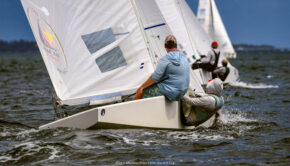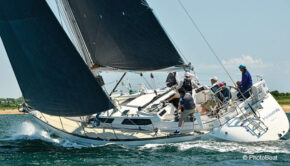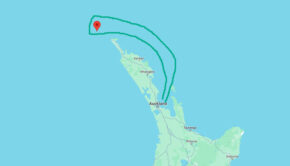Racing Rules vs. Rules of the Road
Published on August 1st, 2021
When two vessels encounter each other on the water, rules exist to minimize the risk of collision. But which rules apply to who and when? Tim Hohmann examines these questions.
All vessels are required to abide by the “Rules of the Road.” These rules were developed by the Convention on the International Regulations for Preventing Collisions at Sea in 1972 and became effective on July 15, 1977 (with amendments in 1983 and 1989) They are commonly referred to as “72 COLREGS” or “IRPCAS”. These rules apply to “all vessels on the high seas and in all waters connected therewith navigable by seagoing vessels”.
In 1980, the U.S. adopted these rules (with some differences) as the U.S. Inland Navigational Rules, applicable to “all vessels upon the inland waters of the United States, and to vessels of the United States on the Canadian waters of the Great Lakes to the extent that there is no conflict with Canadian law.” COLREGS demarcation lines are printed on nautical charts to show mariners in the U.S. whether they’re under the International or Inland Rules.
Boats that are racing (even if they aren’t racing against each other) are also bound by the Racing Rules of Sailing (RRS) that are published by World Sailing (the international governing body for the sport of sailing), with some additions by U.S. Sailing (our national governing body). These rules are updated every four years, aligned to Olympic quadrennials, so the current version became effective on January 1, 2021 and is effective until December 31, 2024.
According to the RRS rule 4 (Acceptance of the Rules) boats that are participating or intend to participate in a racing event agree to accept the RRS. Courts have considered this acceptance a “private contract” between racing boats to replace COLREGS while participating in a racing event. There are subtle but important differences in how racing sailboats under sail are required to interact with each other.
While the sole focus of COLREGS is to reduce risk of collision and ensure safety of navigation, the RRS have three purposes: 1) reduce risk of collision and ensure safety; 2) ensure fair competition; and, 3) provide a tactical tool for competitors to use to their advantage.
So obviously, vessels that are not racing should observe the COLREGS and boats that are racing should abide by RRS when encountering other racing boats. But what happens when a boat that is racing meets a boat that is not? The preamble to RRS Part 2 (When Boats Meet) addresses this by saying that when a boat racing meets a boat that is not, the racing boat shall comply with COLREGS (or other government right-of-way rules, such as the U.S. Inland rules or local ordinances).
For a power-driven vessel (which is obviously not participating in a sailboat race), this means that she must keep out of the way of a sailing vessel under sail (COLREGS 18(a)(iii)), except if the sailing vessel is overtaking the power-driven vessel (COLREGS 13). It doesn’t matter whether the sailing vessel is racing or not, the responsibilities of the powerboat are the same.
Between two sailing vessels under sail, COLREGS rule 12 and RRS Part 2 rules are similar. Port tack gives way to starboard tack, and if on the same tack windward gives way to leeward. There’s an important difference in an overtaking situation. Under COLREGS an overtaking boat must keep out of the way of the boat being overtaken and the boat being overtaken is expected to maintain course & speed until the overtaking boat is well clear.
Under RRS an overtaking boat must keep clear when astern and also if she establishes an overap to windward. The boat being overtaken may maneuver to prevent the other boat from establishing an overlap, and if the other boat is passing to windward the boat being overtaken can alter course to luff the overtaking boat.
But the overtaking boat obtains right-of-way if she establishes an overlap to leeward and then the boat being overtaken must keep out of the overtaking boat’s way. The racing rules ignore the “overtaking” aspect and simply go by who’s windward and who’s leeward.
For a racing sailboat encountering a powerboat or a non-racing sailboat, there is a critical difference in how the racing boat should maneuver. Under RRS a boat with “right of way” is generally allowed to maneuver as she pleases as long as she gives the other boat room to keep clear, and a boat required to “keep clear” is allowed to pass in very close quarters to a right of way boat as long as she doesn’t cause the right of way boat to have to alter her course.
So as we noted before, under RRS a leeward boat can generally luff up as far as head-to-wind and the windward boat is required to alter course to keep clear. Often the windward boat will keep clear by only a few feet, or even a few inches – it’s expected that in a race boats will be in very close quarters.
Under COLREGS, the “stand-on” vessel is required to maintain her course and speed (unless it becomes apparent that the other vessel isn’t giving way), and a “give-way“ vessel is required to take “early and substantial action to keep well clear” of the other boat. So whether racing or not, nobody ever has “right of way” under COLREGS – neither vessel has rights and both have responsibilities to avoid collision.
If a racing boat is the stand-on vessel under COLREGS she’s obligated to maintain her course and speed so that the non-racing vessel (either sailing or power-driven) can keep well clear, even if tactical considerations or a wind shift would otherwise lead the racing boat to change course. And a racing boat which is “give-way” to a non-racing boat has to maneuver early and substantially to avoid risk of collision with a non-racing boat, where she might alter course only slightly to very narrowly avoid contact with another racing boat.
If you’re curious to learn more, you can find a copy of the RRS at https://www.sailing.org/documents/racing-rules.php (or, if you’re a member of U.S. Sailing, there’s a very excellent free iOS or Android app available for download).
A PDF of the COLREGS can be downloaded from https://www.navcen.uscg.gov/pdf/navrules/navrules.pdf (did you know – if your boat is longer than 39.4 feet (12 meters) you are required to have a copy onboard while operating your vessel? A PDF on your phone or tablet meets this requirement).









 We’ll keep your information safe.
We’ll keep your information safe.